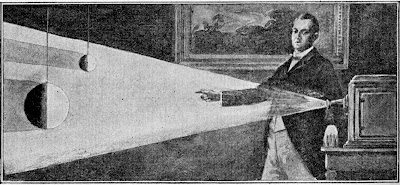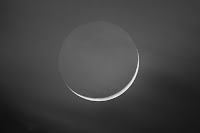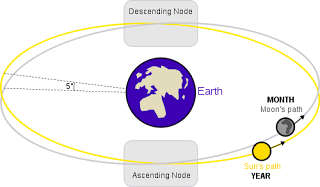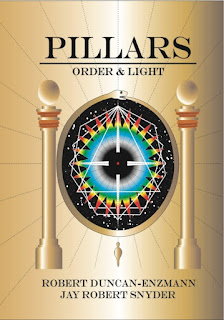 |
| The Enzmann Torch Long Passage Ship, cover of Analog
|
Astronomy is not a subject most people have much training in. Our age of technology has eliminated the need for each person to be able to direct himself by the stars above, or understand the passing of seasons according to the star patterns that accompany them. Yet the greatest human endeavor is the exploration of our vast solar system and the universe it is in. Without knowledge of astronomy, even our technology will not be sufficient to accomplish this - maps of the stars and planets will be made by humans working with machines. Human knowledge is paramount in any great effort, and for those who look to the stars, astronomy is imperative. And so here I share some lessons designed for young people and adults, to convey the wonders of the heavens to those who seek to know more. They are adapted from Starland, by Sir Robert Stawell Ball, 1899, then from Pillars, by J. R. Snyder & R. D. Enzmann, to be published in 2018.
Phases of Our Attendant – The Moon
The first day of the week is related to the greatest body in the heavens – the sun – and accordingly we call that day Sunday. The second day of the week is similarly called after the next most important celestial body – the moon – and though we do not actually say Moon-day, we do say Monday, which is very nearly the same. In French, too, we have lune for moon, and Lundi signifies Monday. The other days of the week also have names derived from the heavens and we will address this, but for now we are now going to talk about the moon.
We can divide the objects in the room into two classes. There are the bright faces in front of me, and there are the bright electric lights above. The electric lights give light, and the faces receive it. I can see both lights and faces; but I see the electric lamps by the light which they themselves give. I see the faces by the illumination which they have received from the electric lights. This is a very simple distinction but it is a very important one in Starland. Among all the bodies which glitter in the heavens there are some which shine by their own light, like the lamps. There are others only brilliant by reflected light, like the faces. It seems impossible for us to confuse the brightness of a pleasant face with the beam from a pretty lamp, but it is often not very easy to distinguish in the heavens between a body which shines by its own light and a body which merely shines by some other light reflected from it. I think many people would make great mistakes if asked to point out which objects on the sky were really self-luminous and which objects were merely lighted up by other bodies. Astronomers themselves have been sometimes deceived in this way.
The easiest example we can give of bodies so contrasted is found in the case of the sun and the moon. Of course, as we have already seen, the sun is the splendid source of light which it scatters all around. Some of that light falls on our earth to give us the glories of the day; some of the sunbeams fall on the moon, and though the moon has itself no more light than earth or stones, yet when exposed to a torrent of sunbeams, she enjoys a day as we do. One side of her is brilliantly lighted; and this it is which renders our satellite visible.
Hence we explain the marked contrast between the sun and the moon. The whole of the sun is always bright; while half of the moon is always in darkness. When the bright side of the moon is turned directly towards us, then no doubt we see a complete circle and we say the moon is full. On other occasions a portion only of the bright surface is directed to us and thus are produced the beautiful crescents and semicircles and other phases of the moon.
A simple apparatus, as in this illustration, will explain their various appearances. The large ball there shown represents the moon, which I shall illuminate by a beam from the electric light. The side of the ball turned towards the light is glowing brilliantly, and from the right side of the room you see nearly the whole of the bright side. To you the moon is nearly full. From the center of the room you see the moon like a semicircle, and from the left it appears a thin crescent of light. I alter the position of the ball with respect to the lamp, and now you see the phases are quite changed. To those on my left our mimic moon is now full; to those on my right the moon is almost new, or is visible with only a slender crescent. From the center of the room the quarter is visible as before. We can also show the same series of changes by a little contrivance shown in the next illustration.
Thus every phase of the moon, illustrated below, from the thinnest beautiful crescent of light that you can just see low in the west after sunset, up to the splendor of the full moon can be completely accounted for by the different aspects of a globe, of which one half is brilliantly illuminated.
We can now explain a beautiful phenomenon that you will see when the moon is still quite young in its cycle. We fancifully describe the old moon as lying in the new moon’s arms when we observe the faintly illuminated portion of the rest of that circle, of which a part is the brilliant crescent. This can only be explained by showing how some light has fallen on the shadowed side; for nothing which is not itself a source of light can ever become visible unless illuminated by light from some other body.
Let us suppose that there is a man on the moon who is looking at the earth. To him the earth will appear in the same ways the moon appears to us, only very much larger. At the time of the new moon the bright side of the earth will be turned directly towards him, so that the man on the moon will see an earth nearly full, consequently pouring forth a large flood of light. Think of the brightest of all the bright moonlight nights you have ever seen on earth, and then think of a light which would be produced if you had thirteen moons, all as big and as bright as our full moon, shining together. How splendid the night would then be! You would be able to read a book quite easily. Well, that is the sort of illumination which the lunar man will enjoy under these circumstances; all the features of his country will be brightly lighted up by the full earth. Of course, this earth-lighted side of the moon cannot be compared in brilliancy with the sun-lighted side, but the brightness will still be perceptible, so that when, from the earth, we look at the moon, we see this glow distributed all over the dark portion; that is, we observe the feebly-lighted globe clasped in the brilliant arms of the crescent. At a later phase the dark part of the moon entirely ceases to be visible, and this for a double reason: Firstly, the bright side of the earth is then not so fully turned to the moon and therefore, the illumination it receives from the earthshine is not so great; and secondly, the increasing size of the sun-lighted part of the moon has such an augmented glow that the fainter light is overpowered by contrast. You must remember that more light does not always increase the number of things that can be seen. It has sometimes the opposite effect. Have we not already mentioned how the brightness of day makes the stars invisible: the moon herself, seen in full daylight, seems no brighter than a small particle of white cloud.
Just like all other planets and stars the moon appears to rise in the east and set in the west every day, but the moon is the only heavenly object to also revolve around the earth. The moon orbits the earth once every twelve months (moon-ths). The moon’s path around the earth is on the same ecliptic plane as the solar-system disk, the same as the sun and planets of our solar system. Another unique feature of earth’s moon is that while it revolves around the earth every 28 days, it rotates only once. This leaves only one side of the moon facing earth at all times, and therefore the other side, the “dark” side, is always facing away, though the dark side is only dark when the side we see is full at sunset. The phases are the same in both northern and southern hemispheres on earth. In the northern hemisphere, the ecliptic crosses from east to west in the south side of the sky. In the southern hemisphere it follows the ecliptic across the northern sky and phases are seen from the opposite side, illuminated from left to right to left.
When the moon passes by the sun in the daytime, it cannot be seen against the blue sky. This marks the beginning of the cycle of the moon’s phases. This first phase is the “new” moon, when the moon rises and sets with the sun, and it is often symbolized as a dark moon against a dark sky; the new moon is in the blue sky all day, but reflects no sunlight towards earth.
As the new moon continues its orbit around the earth and passes away from the sun, it enters its waxing crescent phase for seven days, with the crescent visible in the sky throughout the day. It sets just after the sun in the west and rises later in the day each morning.
After those seven waxing crescent days, the moon reaches a 90° angle from the earth and sun at its first quarter when we see only half of the illuminated surface of the moon – it is half the circle we see, but a quarter of the moon. The first-quarter moon rises at midday, crosses the mid-sky meridian at sunset, and sets in the west at midnight. This begins its second seven-day phase called the waxing gibbous, when our visible half of the moon is increasingly illuminated and the moon rises later in the day each afternoon.
When the moon rises 14 days after its new moon cycle (seven days after its first quarter), it is 180° from the sun and rises as a full moon in the east as the sun sets in the west. The full moon crosses mid-sky meridian at midnight, sets in the west as the sun rises in the east, and begins its third phase, called waning gibbous. The moon’s face is now illuminated on its opposite side. Its first quarter side darkens as it rises later each night for the last 14 days of its orbit around the earth.
After the seven waning gibbous days, the moon is 270° around its orbit and reaches its last quarter; the other half of the visible illumination reflected off the moon is lighting the other side, rises in the east at midnight, and crosses the mid-sky meridian at sunrise. This marks the final phase, the waning crescent, and it rises closer and closer to the eastern sunrise each night. After seven days as a waning crescent, it begins another new orbit as it rises with the sun as a new moon.
As the moon orbits the earth it appears either slightly above or slightly below the ecliptic. When it crosses over the ecliptic as a full moon it is directly aligned with the earth and sun, and the earth’s round shadow can been seen on the surface of the full moon in a lunar eclipse.
When it crosses over the ecliptic as a new moon it is directly aligned between the earth and sun, and as the sun is blocked by the moon, its shadow is cast upon the earth in a solar eclipse. Solar and lunar eclipses only happen during new moons and full moons when the moon’s orbit crosses the ecliptic at those times. Seeing the earth’s round shadow on the face of full moons helped prehistoric astronomers observe the shape of the world they lived on, and they surmised that the earth is round. The full moon also marks calendar events such as Easter, celebrated on the first Sunday following the first full moon after the first day of spring, or the third Sunday of the lunar month beginning on or before March 8th. The Gregorian astronomical calendar, which was calculated in 600 AD, predicts these Ecclesiastical full moons; Easter is celebrated on different Sundays each year.
The moon travels about 13° every 24 hours and makes a complete orbit in twenty-eight days. It progresses through the Zodiac on the same plane as the sun and planets along the ecliptic, and passes through to the next Zodiac constellation every other night. It also begins its new cycle of phases as a new moon in a different Zodiac each month. This makes a convenient way to gauge the passing of time based on the changes of the moon and its position against the stars. A week determines the change in phase quarters, and in a fortnight (14 days) it changes from new to full and full to new each month. Knowing the phases and the positions helps to keep track of passing weeks and months observing the stars that it passes by.
Our prehistoric ancestors predicted the phases of the moon, especially the full moon, which allowed them to hunt game which was nocturnal. Knowing the cycle of constellations was also critical to survival, as the star pictures above indicated the weather patterns below, allowing preparations for planting, breeding, harvesting, hunting, and most especially winter.
About Symbologist Michelle Snyder
Michelle Snyder is a professor of mythology, and an author, publisher, speaker, and artist. She did her post-graduate research at the University of Wales, decoding ancient and prehistoric symbolism, mythology, folklore, and fairy tales. Her artwork has appeared in galleries from Massachusetts to California. Michelle is co-owner of White Knight Studio.
Michelle Snyder
Non-Fiction - Symbology:
Symbology: Decoding Classic Images
Symbology: Decoding Symbols through History
Symbology: Fairy Tales Uncovered
Symbology: Art and Symbols
Symbology: Hidden in Plain Sight
Symbology: ReVision
Symbology: World of Symbols
Symbology: Secrets of the Mermaids
Michelle Paula Snyder
Fiction – Fantasy Wonder Tales:
The Fairy Tales: Once Upon a Time Lessons, First Book
Call of the Dragon and other Tales of Wonder
A Tale of Three Kingdoms, book one: The Lost Unicorn
A Tale of Three Kingdoms, book two The Lost Mermaid












No comments:
Post a Comment